GA4 segments give deep insights into what happens on your site or webshop in seconds. So, if you are not using segmentation yet, it’s time to learn how to cut your tasty web data pie into pieces and look for the sweetest parts. Hungry for more? Read on…
Key takeaways
- Segments in GA4 are easy to set up and a smart way to analyze subsets of your web analytics data.
- In GA4, you can build segments based on data from users, sessions and events.
- You can create GA4 segments in 3 different ways.
- You can use these segments in exploration reports for a laser focused analysis about user behavior, campaigns, etc.
- Segments are the foundation of audiences, which you can target with ads.
What are Google Analytics segments, anyway?
Segments in Google Analytics are subsets of your web analytics data. You can create endless conditions that separate data from users, sessions and events from the rest.

You can use segments in exploration reports. For example, you can display only paid traffic in a path exploration report. In GA4, that looks like this:
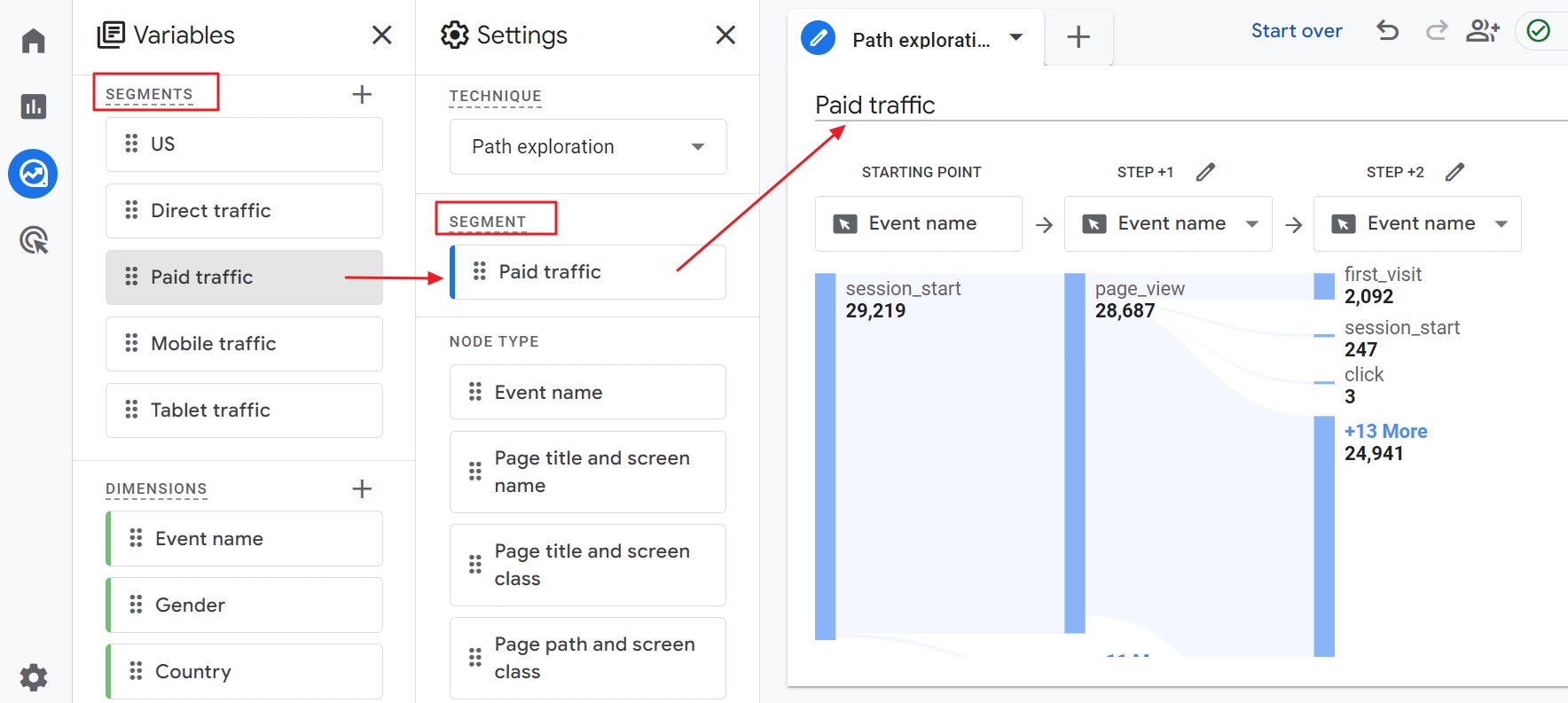
Segments allow you to filter data without losing it from your account. Of course, that’s a huge advantage for marketers and data analysts.
Besides, creating segments in Google Analytics is easy…
How to create a segment in GA4?
GA4 offers three different ways to create segments: manually, from a table of an exploration report, and based on an existing segment.
Let’s start with the toughest method.
Method 1: build a segment from scratch
Segments are highly customizable, and it’s impossible to show the steps for all combinations. Yet, the steps to create a segment are always the same.
Step 1: Open Explore
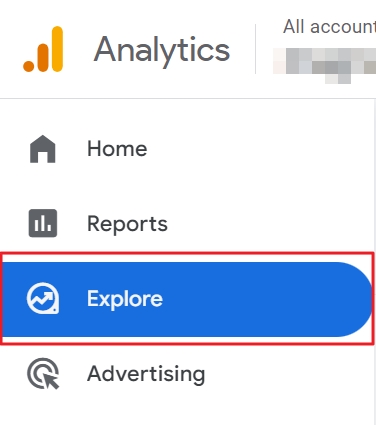
Click Explore in the menu on the left.
Step 2: Click on the + sign

The first exploration is a blank template. I use it here, but you can do it as well with other GA4 exploration templates.
Step 3: Add a segment to your exploration
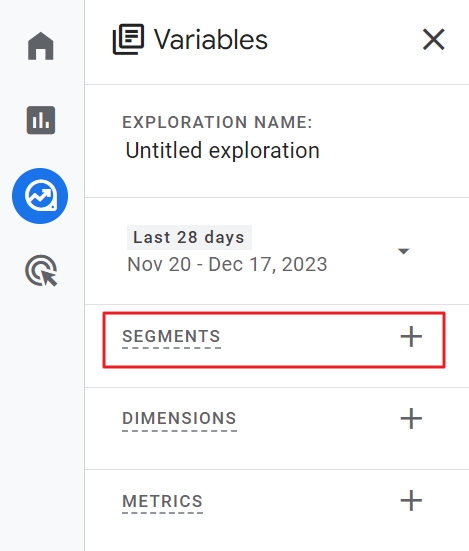
In the Variables panel, click on the + sign next to Segments.
Step 4: Choose the type of segment
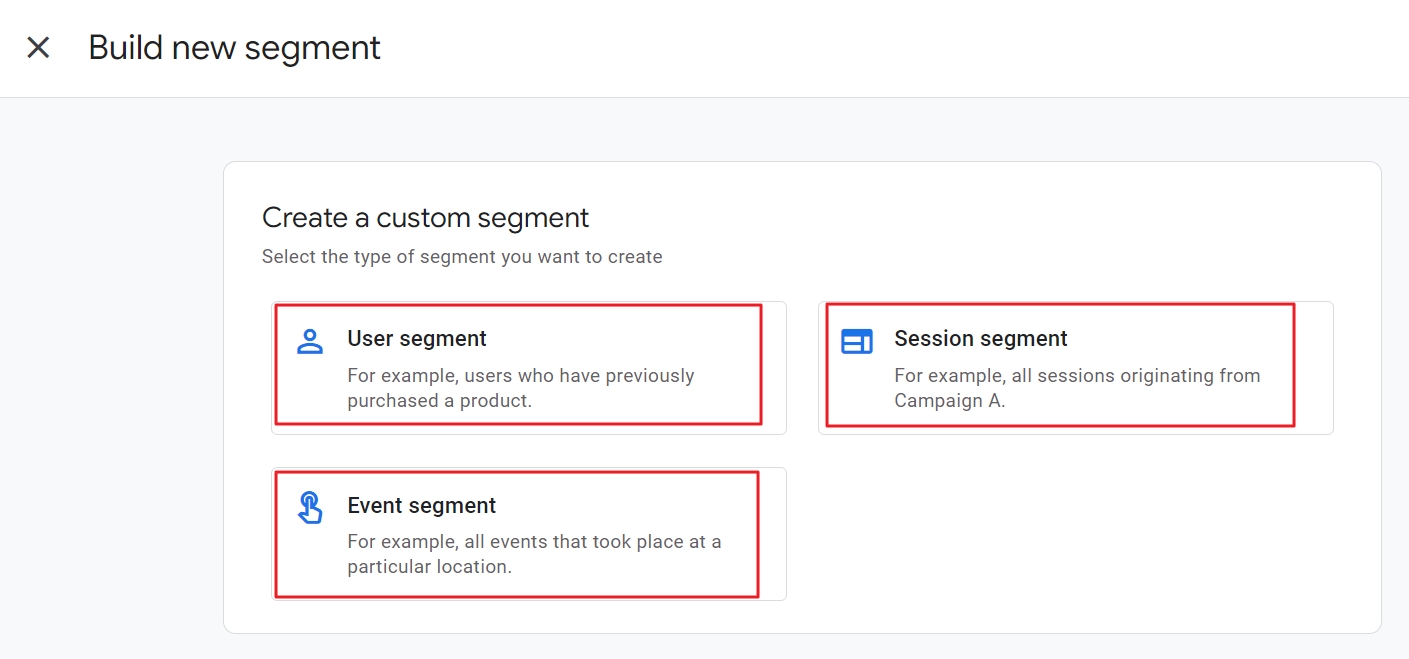
You can choose between three types of segments:
- User: these are your unique GA4 visitors.
- Session: this is the GA4 jargon for a visit to your site.
- Event: what the visitors are doing on your site.
I clicked Session, but further below, I included other examples of how segments can be useful to you.
Step 5: Give your segment a name

It’s best to choose a descriptive name so your team members directly understand what you included or excluded.
For example: “Home page visit”.
Optionally, you can also provide a description.
Step 6: Set up the condition(s) for the segment

This step is key because here you define who/what you want to include or exclude from your segment.
For example, I used the following conditions:
- Include
- Page path + query string and screen class
- Filter: “exactly matches /”. The slash stands for the home page.
You can add more conditions, set up conditions to exclude data to narrow down your selection, and even change the AND into an OR operator.
Step 7: Check if your segment is populated with data
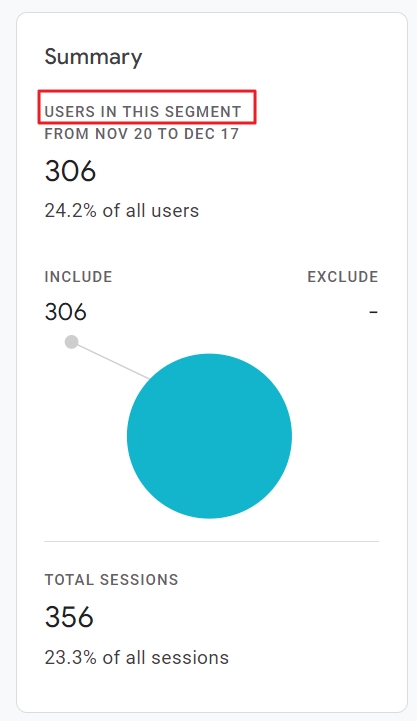
On the right side of the segment builder screen, there is a live update of the data. You can also compare it with the totals for the selected period.
Since all of this is happening instantly, you quickly get some insights, even without setting up an exploration report.
Step 8: Save and apply your segment

You can find the button in the right-top corner.
Now your segment is ready to be used in your exploration.
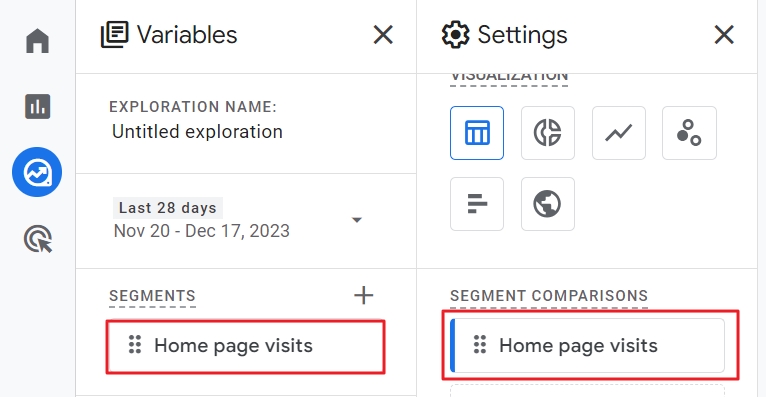
Since we started from scratch, there is no data in the report.
Bummer, but at least you understand which steps you need to take to create a segment in GA4 from scratch.
Here is another bummer.
There is also a faster way to create a segment…
Method 2: Create a segment in GA4 from a table
Sometimes, you notice something interesting in an exploration report. Like, for instance, I did when I was looking at a GA4 report that had relatively many file downloads.
In cases like these, you can right click on the row and then Create segment from selection.
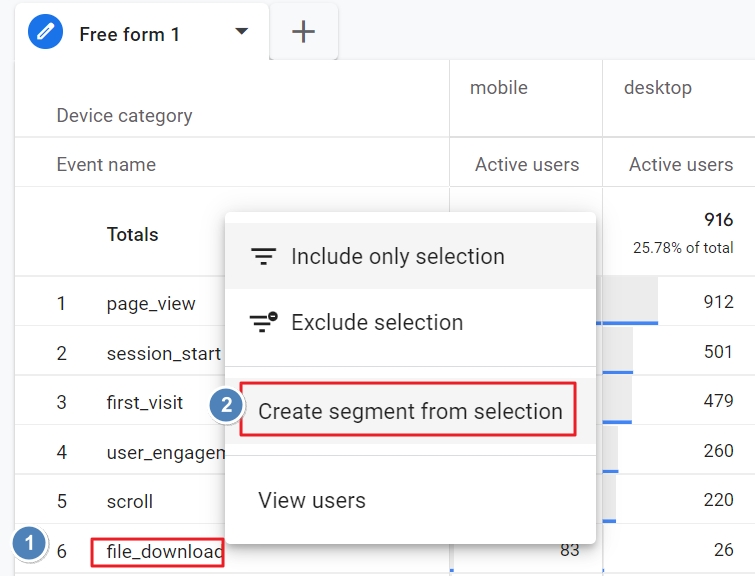
The segment builder screen opens and you can adjust it, add including or excluding conditions, or just Save the segment.
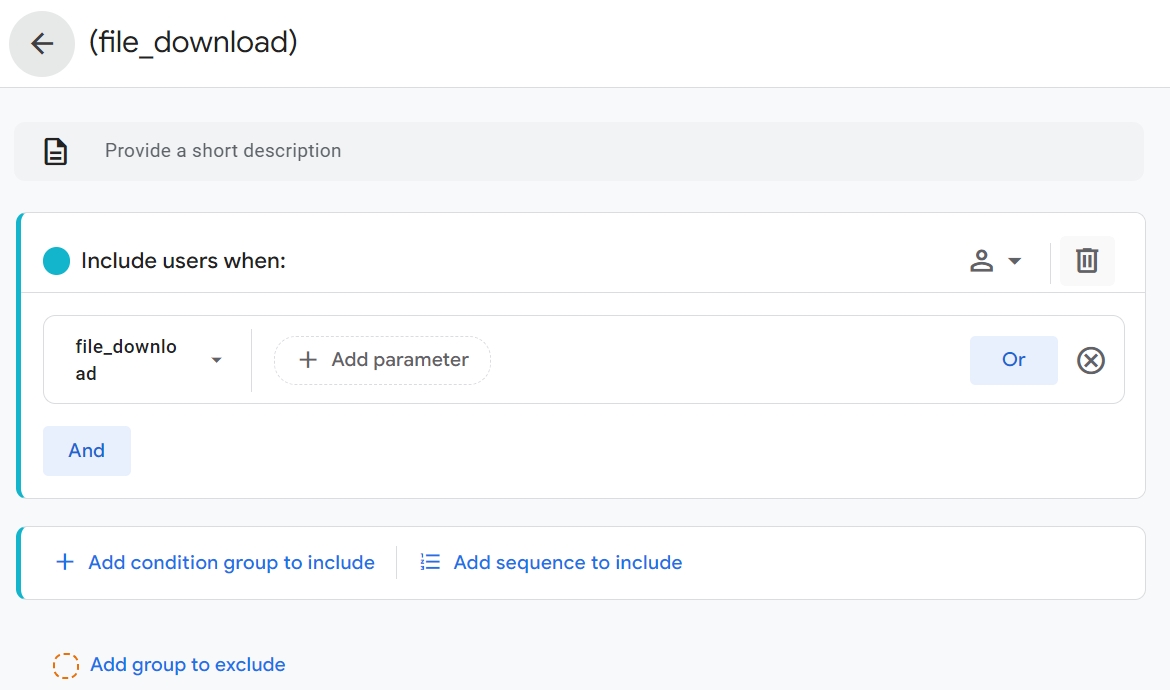
In the example, I used it to add it to the report to compare sessions with and without file downloads.

Method 3: edit an existing segment in GA4
You can change segments that are available in the Variable settings panel. To do so, click on the 3 dots of the segment.
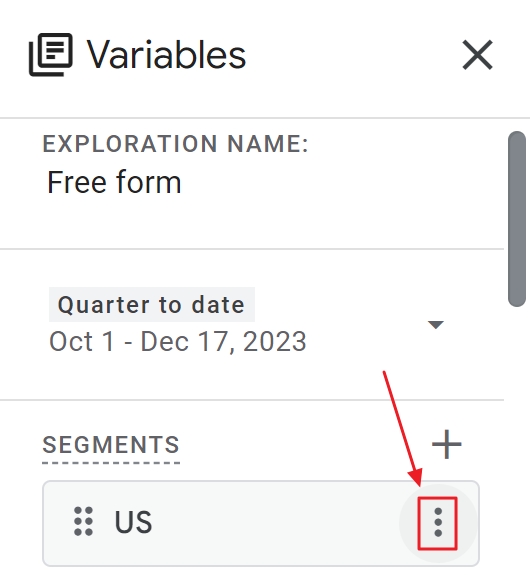
Then click Edit.
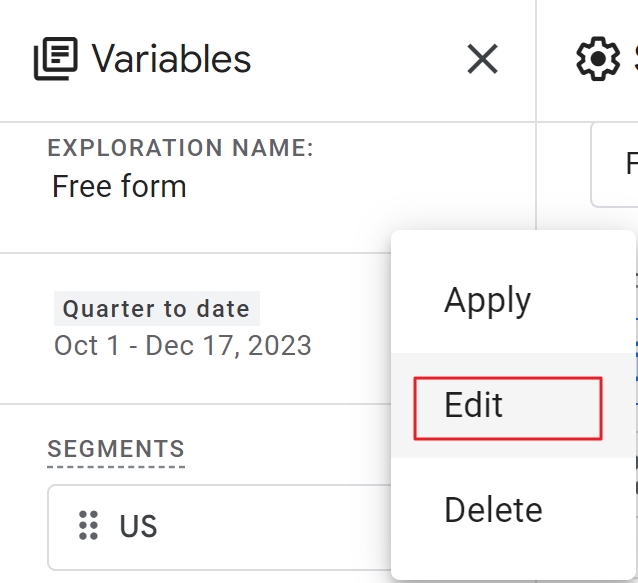
The segment builder screen opens. Now, you can, for example, change the conditions of the built-in US traffic segment.
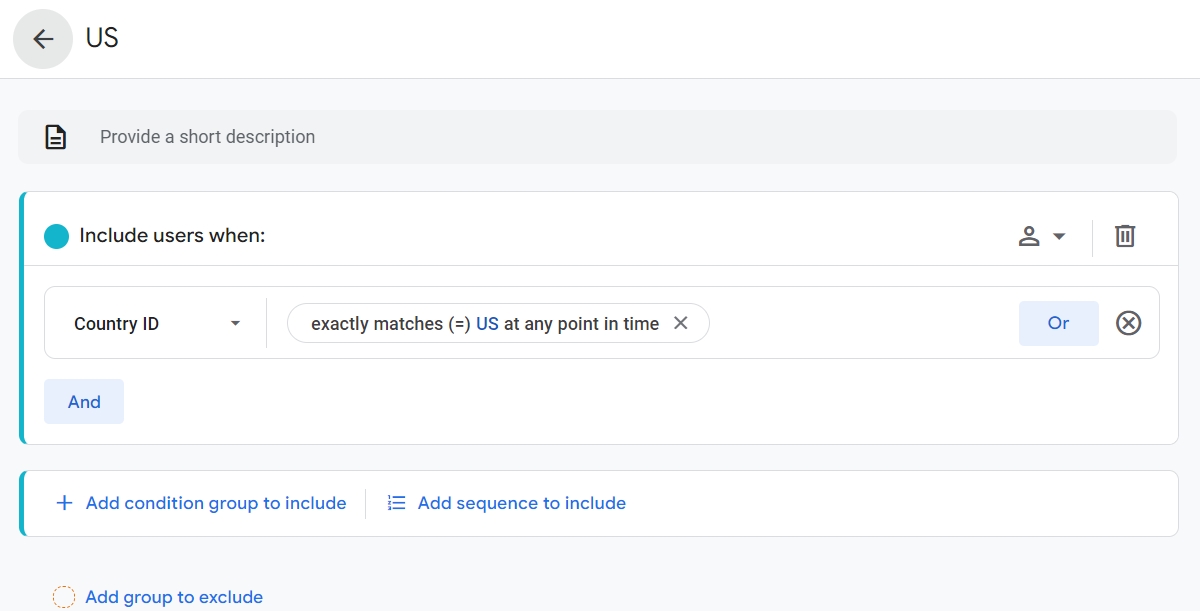
Mind that editing an existing segment can seriously confuse yourself or your team members. The best practice is to give the edited segment a different name and provide a description.
For example, you can create a segment with all your users from the US in the age-range 45-54.
The screenshot below shows which conditions you need to set to create this segment with demographics data.
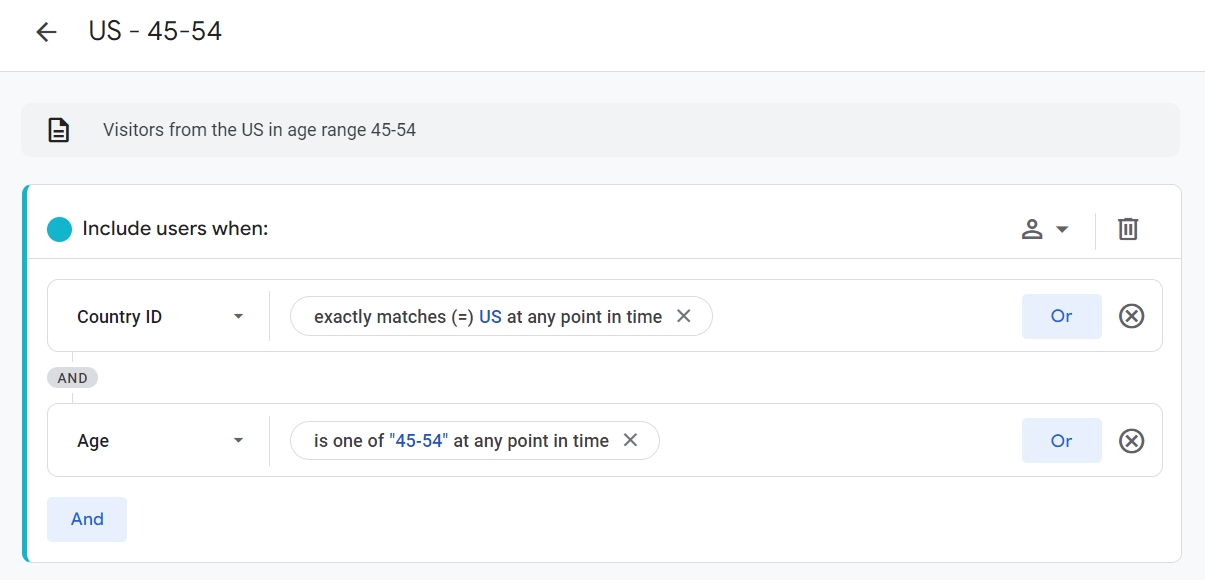
Now you know how to create a segment, it’s time to take a closer look at the 3 GA4 segment types.
The three GA4 segments + examples
In Google Analytics 4, you can create 3 types of segments. These are based on users, sessions and events. That can be confusing, so let’s simplify it first. The details will become clear as we move forward.
- User segments: visitors.
- Session segments: visits.
- Events: actions on your site.
User segments
To analyze data that is related to users, aka visitors, segments come in handy. You can set conditions to include or exclude users, based on events, dimensions and metrics.
Events
You can, for example, segment users who added an item to the shopping cart, but didn’t check out. In the GA4 segment builder, the configuration looks like the screenshot below.
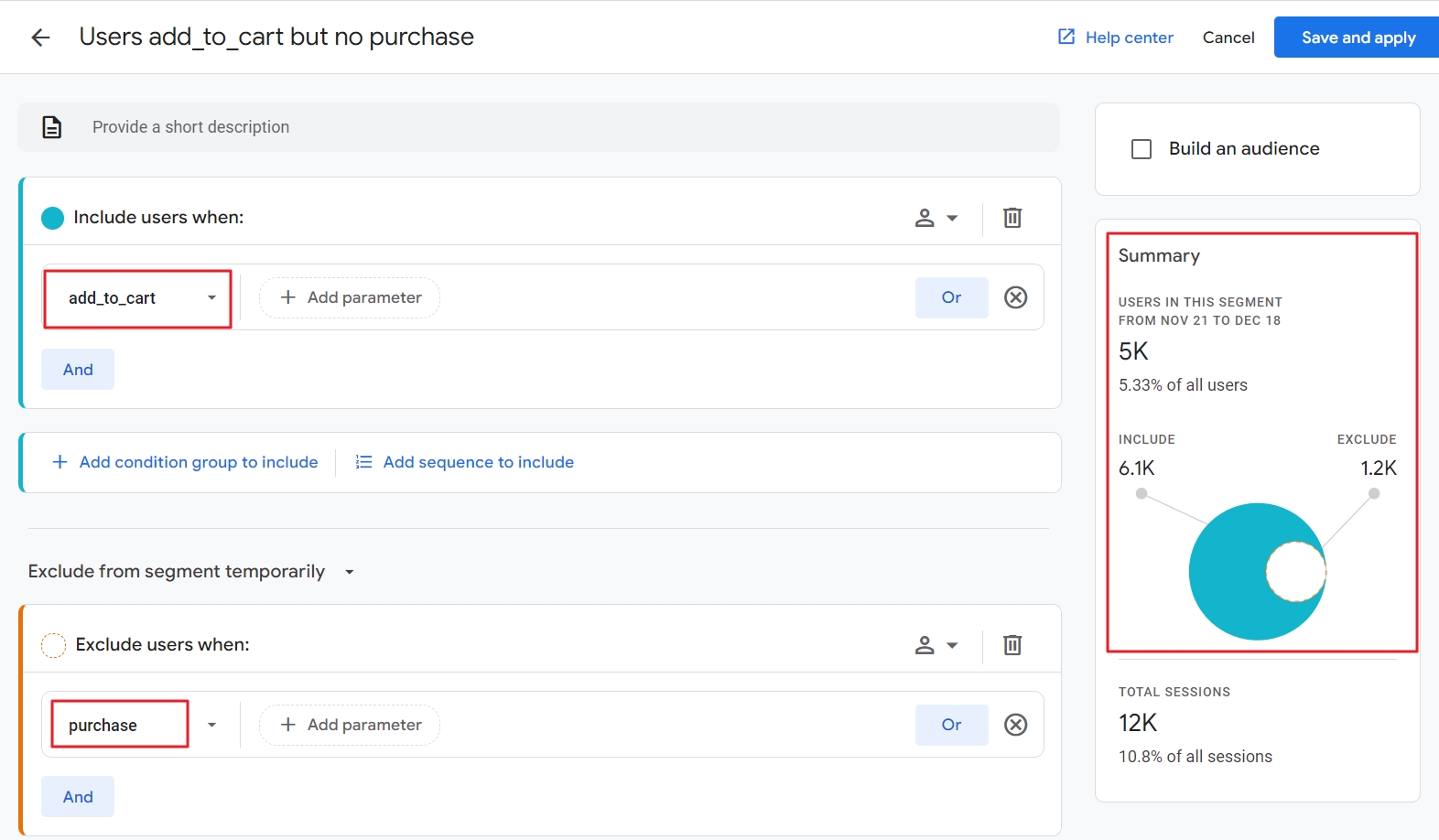
You can use this segment in an exploration, but you can also see important data in the segment summary card:
- Total amount of users that added a product to the cart.
- The percentage of this segment, compared to all users.
Dimensions
You can use tons of dimensions to segment users: attribution, custom, demographics, ecommerce, event, gaming, general, geography, link, page/screen, platform / device, publisher, session, time, traffic source, user, user lifetime, and video.
Each dimension opens the door to even more segmentation conditions that you can apply. It’s too much to list here.
To make things more complicated, GA4 dimensions have three segment scopes.
- User-scoped
- Event-scoped
- Session-scoped
Does that ring a bell? If not, here is a reminder. The conditioning scopes exactly match the basis of the segments.
Let’s take one example and narrow down the user segment we started above.
This time, I added a condition for demographics: female visitors.

The summary card of the segment instantly updates and shows data for female users that added an item to a cart, but didn’t purchase.
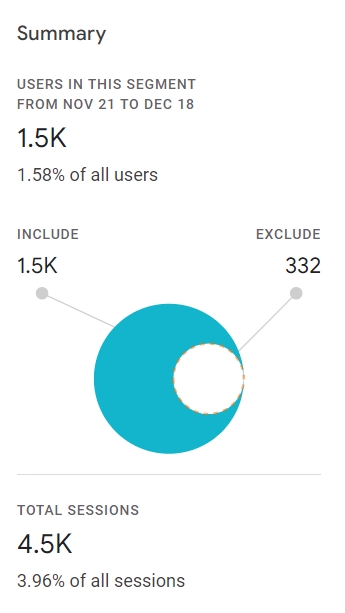
Cool and powerful. Isn’t it? And it gets even better.
So far, we looked at the past to see what subsets of your users did on your site.
But did you know GA4 can also look into the future?
Predictive metrics
GA4 uses AI for predictive metrics. That allows you to, for example, segment users that are likely to buy from you in the next 7 days.
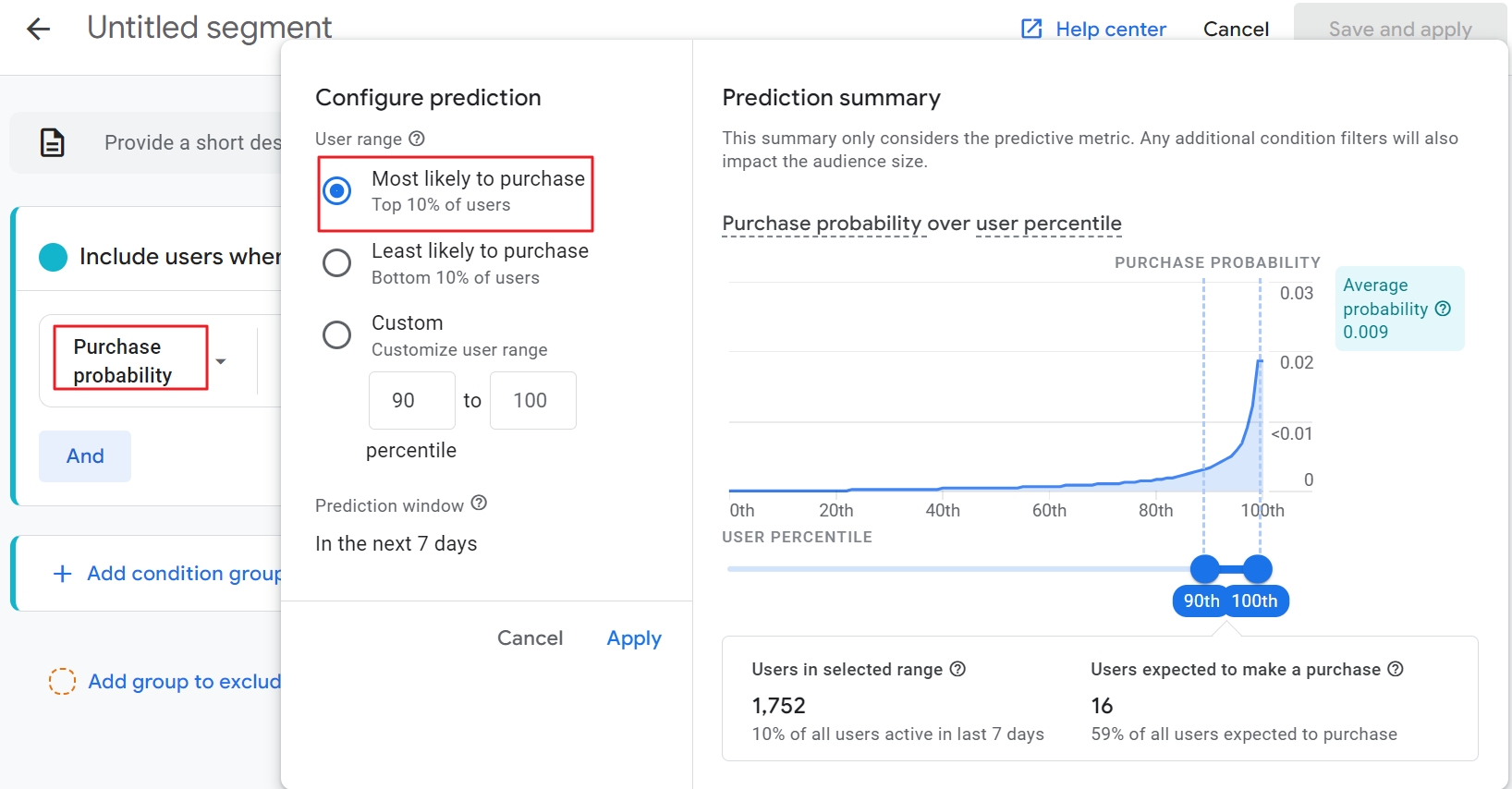
In the screenshot below, you can see the user predictive metrics applied to a segment.

A more powerful option than using this segment in a report is to build an audience with it.
You can then target this predictive audience with ads.
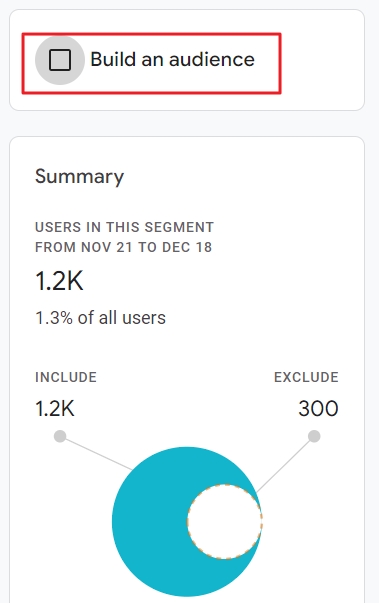
Mind blowing, isn’t it?

Session segments
A session segment focuses on visits, rather than visitors. One user can visit your site several times and therefore this is also a useful way to create subsets of your data.
Another difference between user and session segments is that you can only use metrics for users.
The other condition setups are the same. So you can create session segments with user-scoped, event-scoped and session-scoped dimensions.
This allows you to, for example, detect how many sessions with a conversion also caused errors. In the screenshot below, it was 0.54% of all sessions.
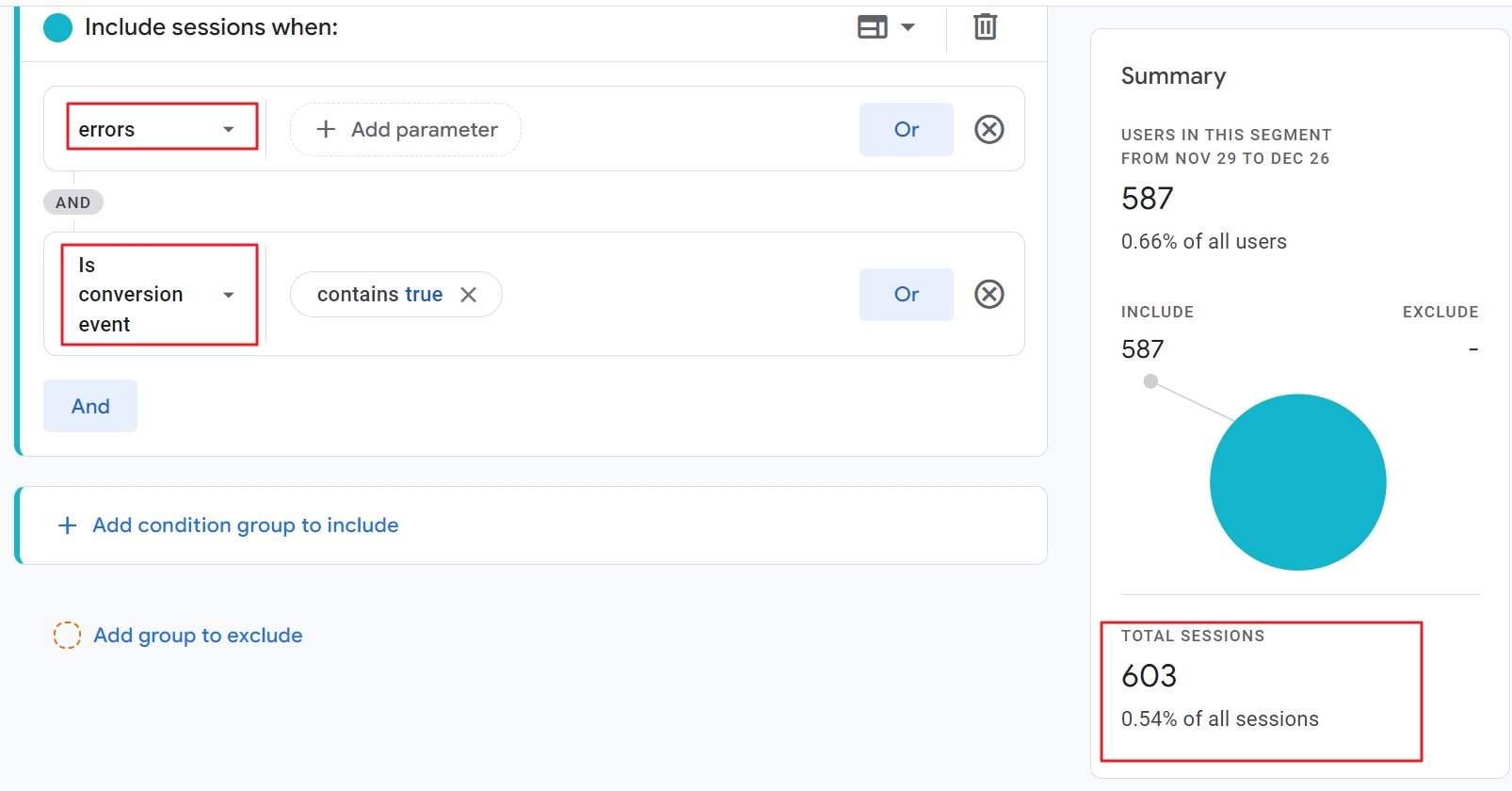
GA4 event segments
Segments based on what users do on your site or web shop are another powerful way to get deep insights.
You can, for example, create a segment for the add_to_cart event and exclude all traffic that was driven by a particular newsletter.
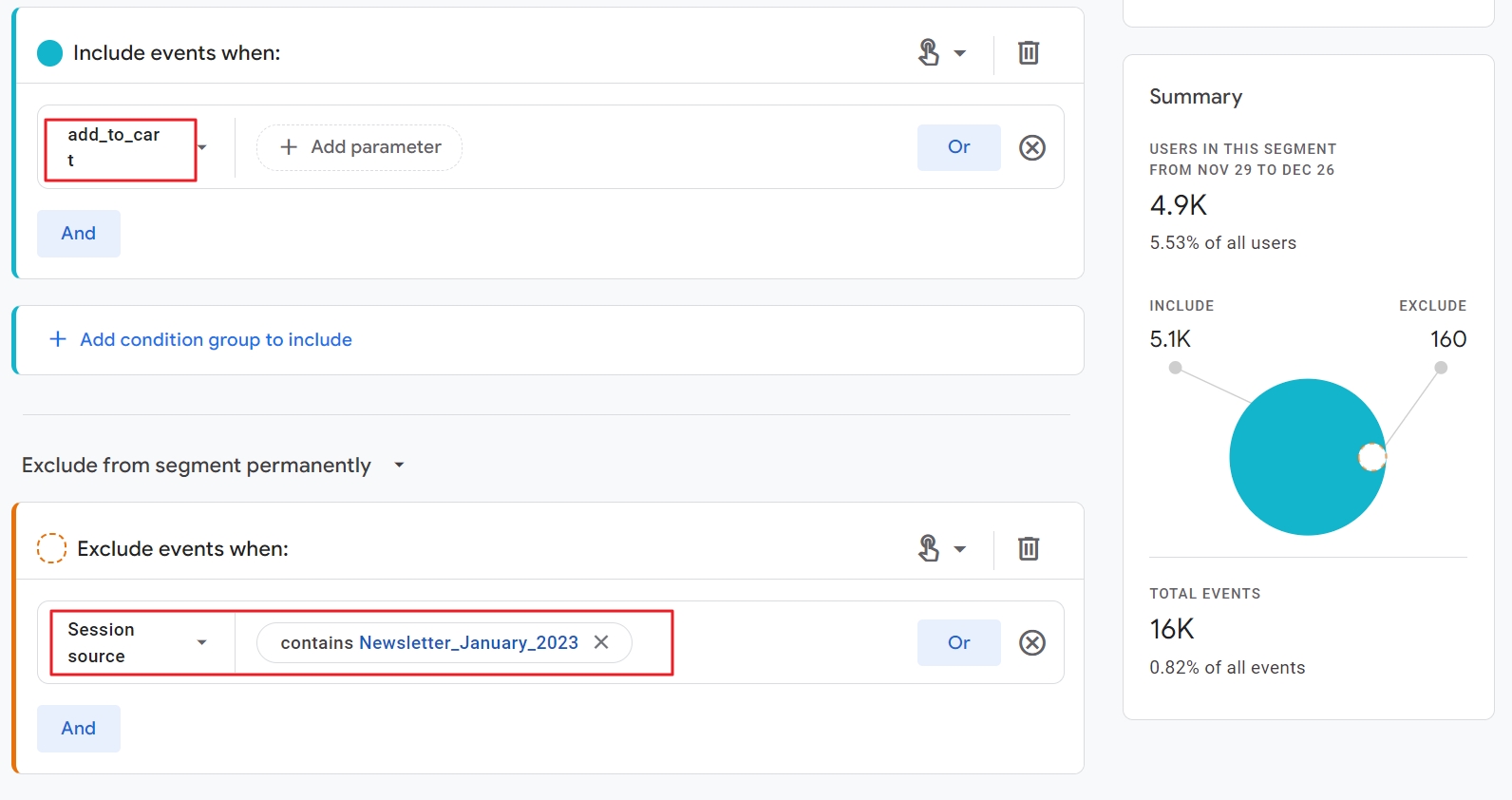
I told you.
There are endless possibilities to create segments in GA4.
And it doesn’t end here…
Advanced segmentation tricks in GA4
There are endless segment combinations in GA4. It’s therefore tempting to create thin slices of the data pie. But to be honest, this is mainly useful if
- You have a substantial amount of visitors on your site.
- You run a web shop or monetize your site in another way.
- You run lots of campaigns simultaneously.
- You have hyper detailed questions about your campaigns or the user behavior on your site.
Conditioning scoping of segments
For each condition group, you can set a scope. To do so, click on the icon.

For user segments, for instance, you can then choose one of the following scopes:

- Across all sessions
- Within the same sessions
- Within the same event
Session and event segments have fewer options for conditioning scoping. This scheme shows which combinations you can use.
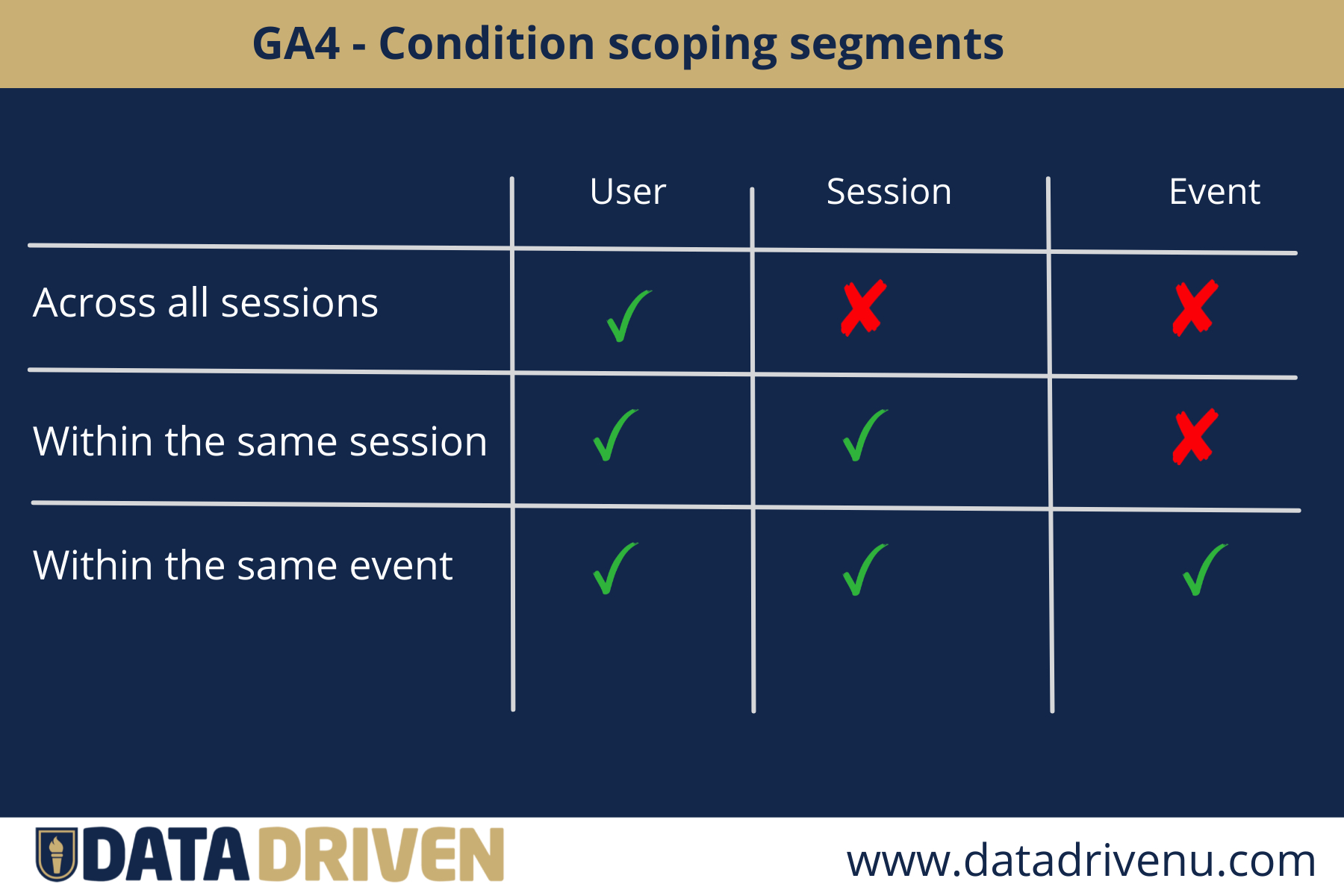
Let’s look at one segment example that uses conditioning scoping.
Let’s assume you want to analyze all users (User segment) who meet the following criteria in a certain period:
- They landed through organic traffic on your site.
- They converted.
- Within the same session (conditioning scoping).
In GA4, the configuration looks as follows:
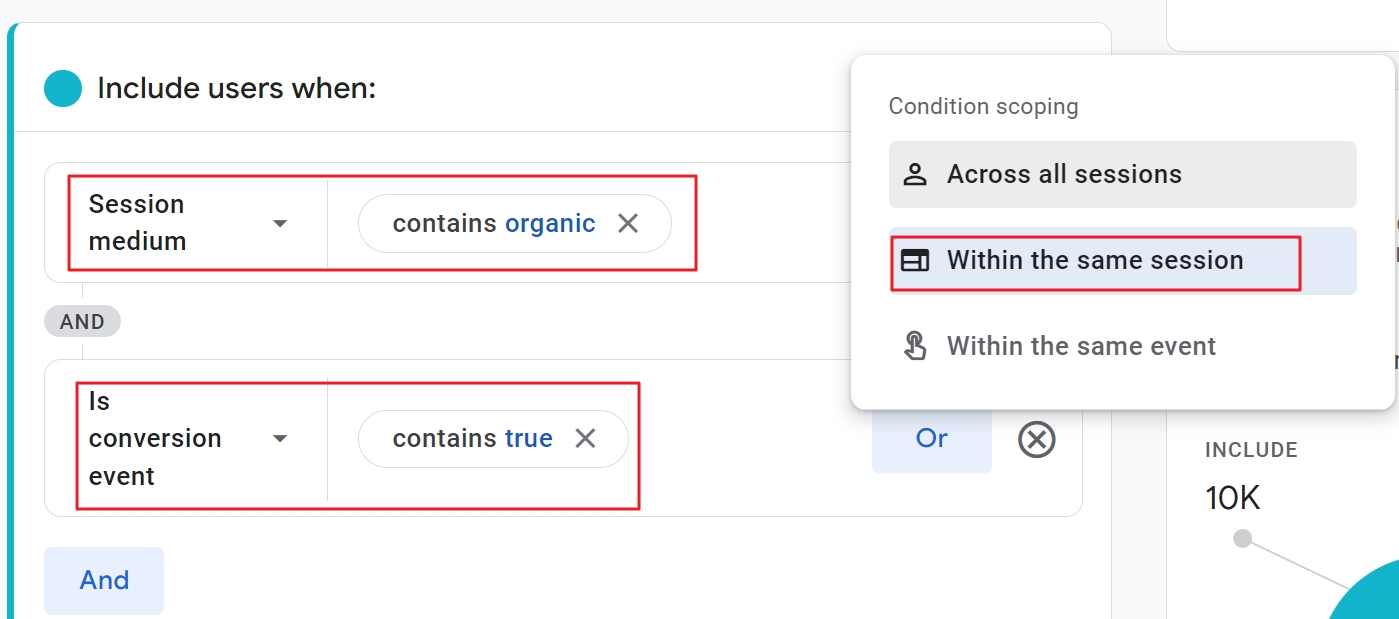
Now, let’s take it one step further.
GA4 segment sequence
You can create segments based on a sequence of actions users did on your site.
You can add a sequence by clicking on Add sequence to include below a condition group.
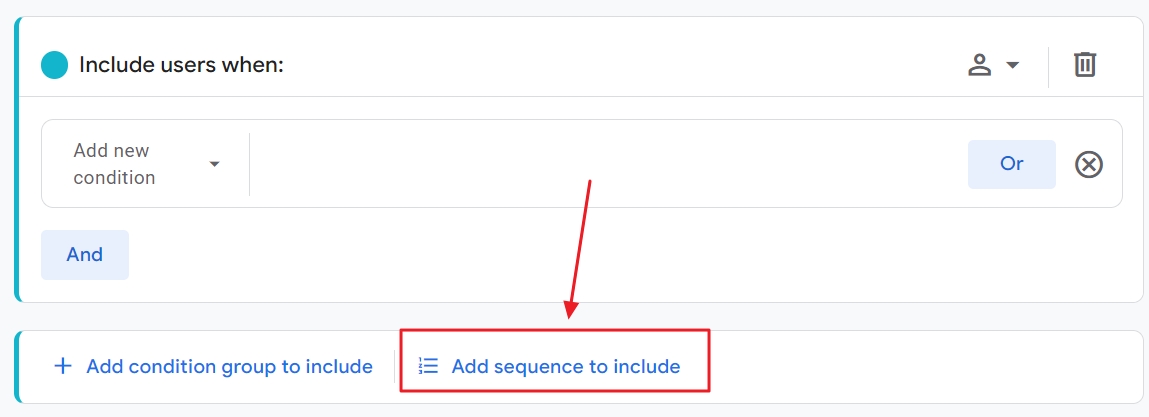
Then, you can set up the conditions for the first step and add more steps that have different segmentation conditions.
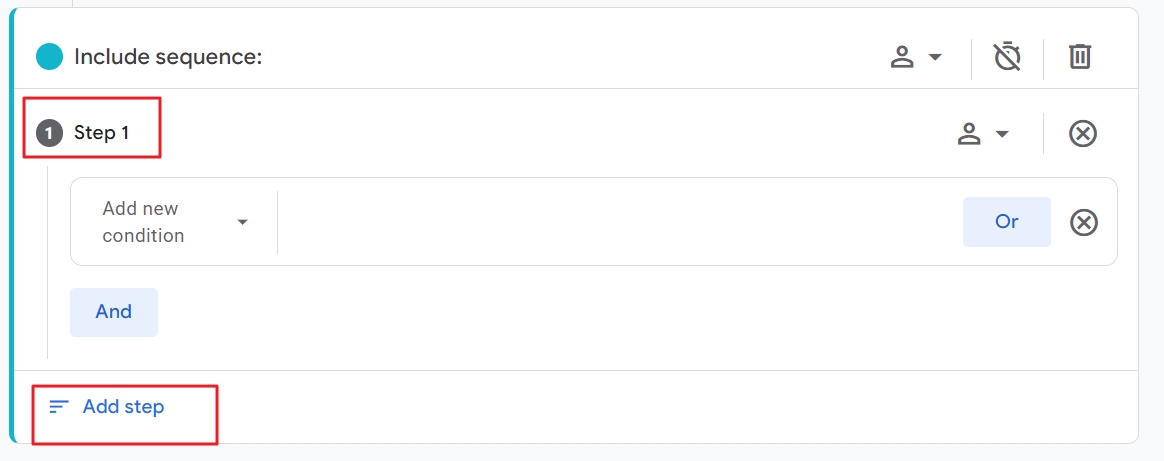
It is like building a funnel segment with live data showing up in the card. You can even configure if the steps need to directly follow each other, or not.
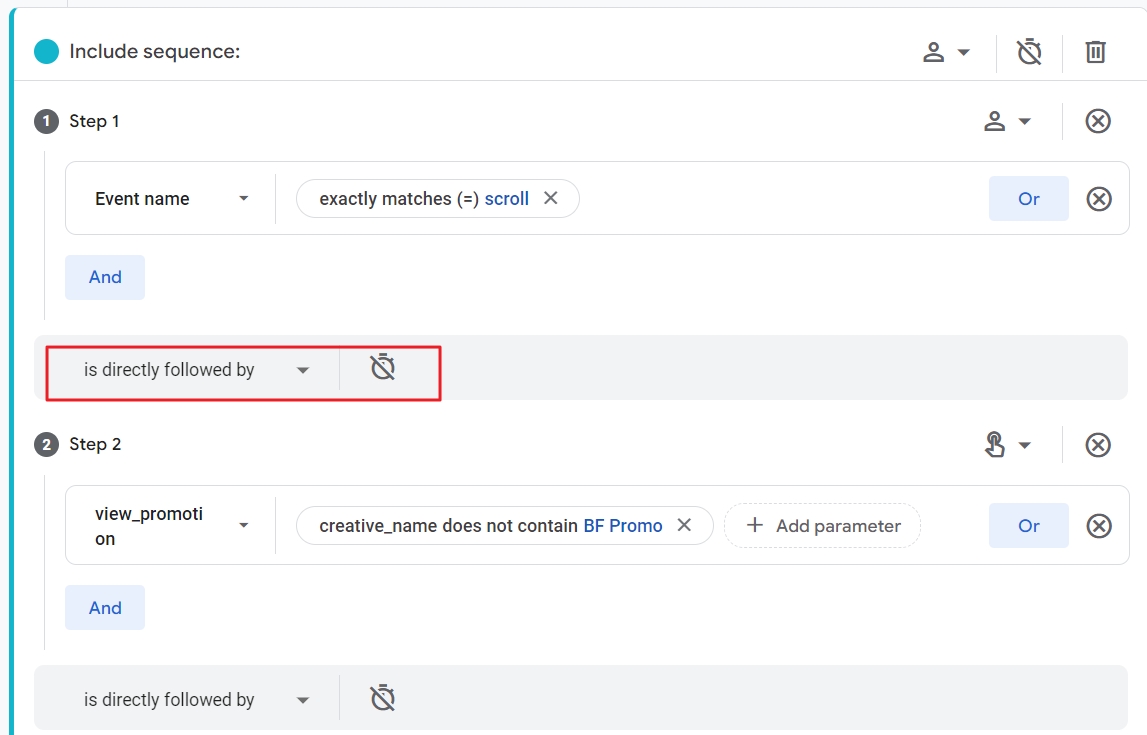
A practical usage of this is for big ecommerce sites that want to thoroughly understand which steps users take before a purchase.

Since time is of the essence, you can even set a time constraint for a step.

Just activate the setting, choose a period and click Confirm.
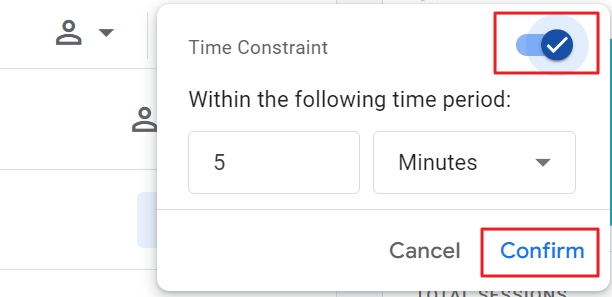
You can use this, for example, to create segments for your promotions that run with countdown timers.
What now?
Creating segments in GA4 is a powerful way to analyze users, events and sessions. But it doesn’t end here.
You can also create a segment overlap report in GA4.
Segments are also the way to create audiences and target them with ads. But in that case, make sure your site is compliant with privacy rules, like the GDPR, CCAP, etc.
Our free privacy-led handbook for marketers helps you achieve this without spending weeks on figuring it out yourself.
On behalf of the DDU team, thanks for being here. I am out now, because I am really curious in which GA4 segment your visit will show up.
